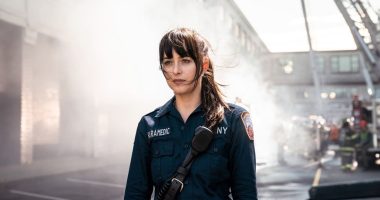It’s no easy task to bring the world of animation into live-action. When it comes to Avatar: The Last Airbender, with its expansive kingdoms, mystical creatures and deities (and of course physical-defying bending abilities), the task might almost seem insurmountable. But VFX supervisors Jabbar Raisani and Marion Spates proved to be more than up for the task, bringing their combined knowledge and experience from working in everything from Westeros and the Upside Down to the MCU and the far reaches of space, to recreate the world of Avatar and bring new layers to it with their own blend of artistry and science.
The Hollywood Reporter spoke to Raisani and Spates ahead of the series’ launch (it’s now streaming in full on Netflix) to hear their thoughts on translating one medium to another, the most challenging element to create onscreen, the nightmare fuel of Koh and what they hope more audiences will recognize about the work that goes into the VFX industry.
***
You guys have quite impressive résumés, but I imagine translating some of the visuals of an animated show to live-action is a whole different challenge.
JABBAR RAISANI Absolutely. I can go back to my own history with Game of Thrones and bringing this beloved book to life in a live-action adaptation. The difference between Thrones and Avatar is that there were no visuals that went along with Thrones, so that was the extra challenge. On a show like Avatar, you have a massive fanbase who is very, very adamant that the show needs to be like the animated show and we certainly wanted to honor that. And we had a visual template that already existed. So for us, it was constantly going back to the animated series at every stage to make sure we were not deviating too far. And anywhere where we had to tell a story that was not previously established by the original series, we really tried to be influenced by how would they have done if it had been in the animated series.
I’ve talked to a VFX people on different projects and they’ve told me that water and fire can be particularly difficult in terms of creating realistic effects. So I’m curious if they were most difficult element to work with in the series?
RAISANI Yeah, Marion and I have a little bit of a different opinion there (laughs). But I’ll say for us, it’s air and water. I’m air. How do you showcase air, right? Air is everywhere. It’s shared by all of us. So, one thing we wanted to do was figure out, how do we portray that right, without just giving it some kind of color? So, we leaned into some distortion methodologies, and I know you’re familiar with F-22. If you look at a photo of an F-22’s engine, you’ll see some really awesome heat distortion. That type of distortion was one of our main ingredients, and that would be our high-frequency distortion. And then we had some larger distortions that would be included to give it some variation, and then we would also pass those distortions through smoke simulations to give it depth. And then finally, wherever the Airbender is bending, we would pull from the substance around them — whether it be sand, snow, water or particulates off a boat to give it one extra last bit of substance and texture.
MARION SPATES And I think it’s waterbending (laughs). We all know what water looks like, and we all know the rules that we live by when it comes to gravity and friction and physics. And with waterbending, we have to take something that we’re all very familiar with and make it break all of those rules, but somehow have you believe that it’s something that’s real. I thought that was really challenging.
The initial batch of screeners I got didn’t have the finished VFX, which was interesting in a way because I got to see part of the process. I’ve gone back since then and watched scenes from the updated screeners so I could see all of your work, but in terms of the VFX process and scheduling, is it common for you to work up until the last minute, perfecting everything, or do things typically come together a little earlier?
RAISANI Well Richard, I will tell you that you still haven’t seen the final visual effects (laughs). Only as of last night were they completed and on the server so, when you watch it tonight at midnight, you will see the final visuals. But look, yeah, it’s a challenge. I think we are always pushing the envelope of what’s possible. We’re always trying to make things better, and we’re always pushing up to the last minute, it seems. And that’s not by design, it’s just because I think we really want it to be the best that it can be. I was texting the Duffer Brothers — Marion and I actually both worked on season four of Stranger Things — and I was messing with them, saying, “Hey look, we actually delivered this even later than Stranger Things season four.” And then they’re like, “You do realize that you guys are the common denominator between those two things” (laughs). But we wanted it to be the best possible version of the show it can be, and we want the fans to love it, and we wanna love it and be proud of it so, I think we’re always gonna push.

A VFX creation in Avatar: The Last Airbender: Hei Bei, an angry forest spirit.
Courtesy of Netflix
I wasn’t surprised to find out that you guys worked on Stranger Things when I saw the design of Koh, which was fantastic. Was any of that practical or was that all VFX?
RAISANI That was all digital, yeah. For the various creatures, we were always trying to find the core of that creature. Obviously, there’s a lot we were working with from the animated series but for Koh, it was like, how do we make a really disgusting creature? How do we make this thing terrifying and gross? So, there was a lot of there that really motivated the choices that we made. And George Takei voiced him and he was awesome. We got to hang out with him on set, and we all took our photo with him. He’s a super nice guy, and gave a great performance so that was super fun.
There are quite a few big set pieces, and I was surprised by what the finale was able to showcase in terms of VFX. What was the standout sequence for you in terms of taking the most amount of time to perfect?
SPATES I mean, it’s gotta be Koizilla. That’s the biggest in terms of simulations, and a lot of different versions. Even the final look that we did in color took four times the color than that of typical coloring, because of the nature of the effect with the black and white, and trying to figure out what’s the recipe for black and white because all the fire bending is how you see the color in Mozilla. Scanline worked on that and they did a great job. We went all the way back to Godzilla for references to look at like how big Godzilla is, how Godzilla screams and yells, and how that high frequency affects his neck and his face. We really had to think about how to make a water creature feel heavy, but also get the point across that it’s a water creature. That itself took some time to figure out, getting that balance between water versus weight. Yeah, to me that one took the most time. And then all the destruction that he’s doing, the simulations, and versions and digital doubles and yeah, all of the hard things (laughs).
There’s been a lot of discussions lately about the VFX industry in Hollywood, in terms of the amount of work that you are asked to do and the time crunch that some studios expect. And yet, along with that, some viewers love to pick through VFX, looking for flaws, and then place the blame on the VFX artists while not understanding what all goes into production. What’s something you wish more audiences took into consideration when they’re looking at effects or something about your artistry that you feel isn’t entirely recognized by viewers?
SPATES It’s just the work that we put into it. I wish people, instead of thinking, “oh, there’s so much CGI” as a negative thing, would consider all the work that we put in, all the artists. There are so many. Even artists who don’t even have their names on the back end of our episodes and our films. Everyone is trying to do their best job to make the best images, and I would just wish that people would take it in and look at it from a story point, and not sit there and try to critique so much. Ultimately, we’re just helping tell a story. We’re not trying to make a CGI show just because we want to have a CGI show. It’s about bringing the story to life and recognizing that they need help to do this, because you can’t film all the stuff that we’re trying to do. So, I think they just need to look at it from the story perspective that we’re helping to tell the story.
RAISANI Another thing that people don’t always understand is that the effects is often the last line of defense. We do our absolute best in production to acquire the best material, but sometimes that material isn’t as good as it needs to have been. VFX are the last people who are trying to make it work, and what they start with a lot of times isn’t ideal. If the perfect element or the perfect plate had been captured, I think the bar could be much higher for those effects. But when you get an entire scene that’s supposed to be exterior day that’s shot interior stage, that’s a hard starting place for a visual effects team to work with. I don’t think people understand or appreciate that a lot of those artists who are working on those shots had no opportunity to partake in the decision-making that led to these shots that they’re getting, but we’re all working to deliver the best results we can achieve.
Avatar: The Last Airbender is now streaming on Netflix.
Also Read More: World News | Entertainment News | Celebrity News







